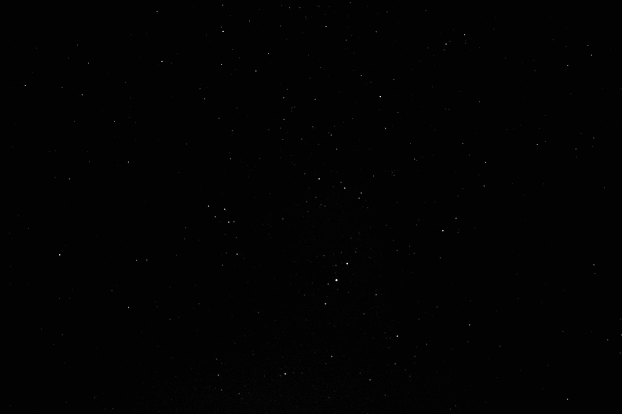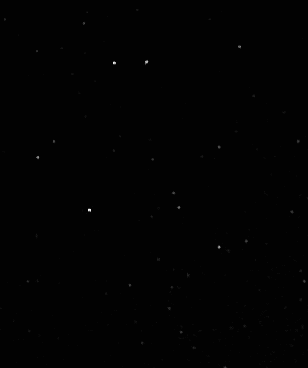
Sagitta, the Arrow
Delphinus, the Dolphin
Equuleus, the Foal

These four constellations are small and I captured them on a single exposure. There is little to say about any of them, so I am including them on this single page. The first picture is the whole frame and moving your mouse over the image will reveal the four names and indicates which constellations surround them. Below this image are enlargements showing each constellation and what little of interest is within them.

|
The picture was taken with my Canon 1000D DSLR with a focal length of 18 mm, an exposure of 20 seconds at f/3.5, ISO 1600. It was reduced from the original 10 megapixels and enhanced by increasing the contrast and decreasing the brightness and removing the colour of the light pollution before rendering in monochrome. |
Vulpecula—The Fox
Vulpecula has no mythological connections.

|
The main object of note is M27 a bright planetary nebular called the Dumbbell Nebula. The milky way passes through the constellation so there are a number of open clusters there including NGCs 6823 and 6230, and two much bigger clusters, Stock1 (1°), and CR399 (2° 20') in which are stars bright enough to show in my picture. The constellation is faint and only one star has a Bayer designation (α magnitude 4.4), so I have labelled the others with their Flamsteed numbers, and have used them to indicate the extent of the constellation which is bigger than some maps imply. |
Sagitta—The Arrow
Although all the stars are faint, this asterism has been recognised as an arrow in many cultures. (The shaft is associated with δ, γ, and η, the nock by α and β.) In Greek legend it is associated with the arrow used by Hercules to shoot the eagle that ripped the liver from Prometheus each day as a punishment from Zeus for giving fire to humanity.

|
Delphinus is a very small constellation and the only significant object is M71 which is interesting because astronomers cannot agree on whether it is a globular cluster or an open cluster. 2- and 15-Sagittae are easy doubles. Note that the star labelled 1 really is 1-Sagitta and lies right on the boarder with Vulpecula. Although small, the constellation is bigger than often appears and extends right into the top left-hand corner and almost into the top right-hand corner of my picture. The two bright stars on the right edge of the picture are 110- (upper) and 111-Herculis but are close to the boundary with Sagitta. The boundaries of constellations can be very strange. |
Delphinus—The Dolphin
Arion was a musician who sang to the kithara, a type of lyre. He won a musical competition in Sicily and travelled back to Corinth with valuable prizes. The sailors plotted to kill him and steal his prizes. They gave him the choice of committing suicide and being buried on land or being thrown into the sea to drown. He asked to sing one last song and sung a praise to Apollo. This attracted dolphins to surround the ship so Arion threw himself into the sea and one of the dolphins carried him to the sanctuary of Poseidon at Cape Metapan on the southern tip of mainland Greece. There the dolphin beached itself to deliver Arion safely to land, and Arion rushed off forgetting to help the dolphin back to the sea so it died. In recognition, Apollo placed the dolphin amongst the stars.

|
Delphinus is a small constellation and there is little of interest in it. The primary stars have odd names given to them by Nicolaus Venator by reversing his own names. γ is an easy double (separation 12 arc-seconds). HR Delphini is a nova that flared up in 1967 reaching a magnitude of 3.7 and remaining visible to the naked eye for several months. It has now faded back to its original magnitude of 12. It is a type of variable star known as a cataclysmic variable. These stars have companions in close orbits which from time to time dump matter onto the primary star causing the outburst. In this case close study has yielded a surprising amount of detail about a system 3,000 light years away. |
Equuleus—The Foal
Although this is one of Ptolomy's original constellations, its origin in mythology is obscure. It has been linked with Kullaros (Cyllarus in Latin), a steed given to Kastor (Castor) by Hermes (Mercury) or to Polydeukes (Pollux) by Hera (Juno), but also with the horse struck from a rock by Poseidon (Neptune) in a contest with Athene (Minerva), and others.

|
There is little of interest in this tiny constellation. It lies close to the plane of the Milky Way so is filled with faint stars, and its brightest, γ, is only magnitude 3.5. ε is visually a triple star, but actually contains four components. |